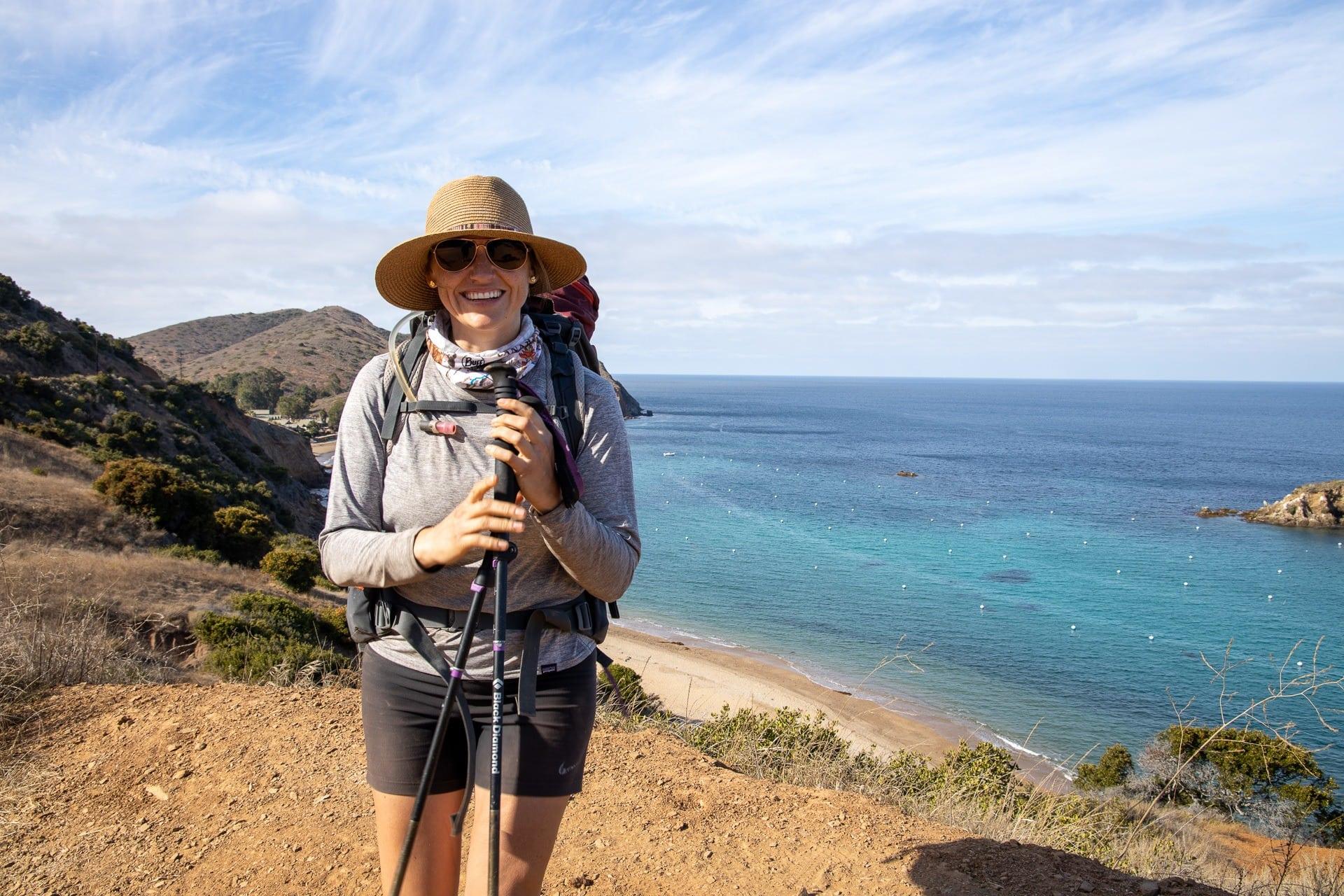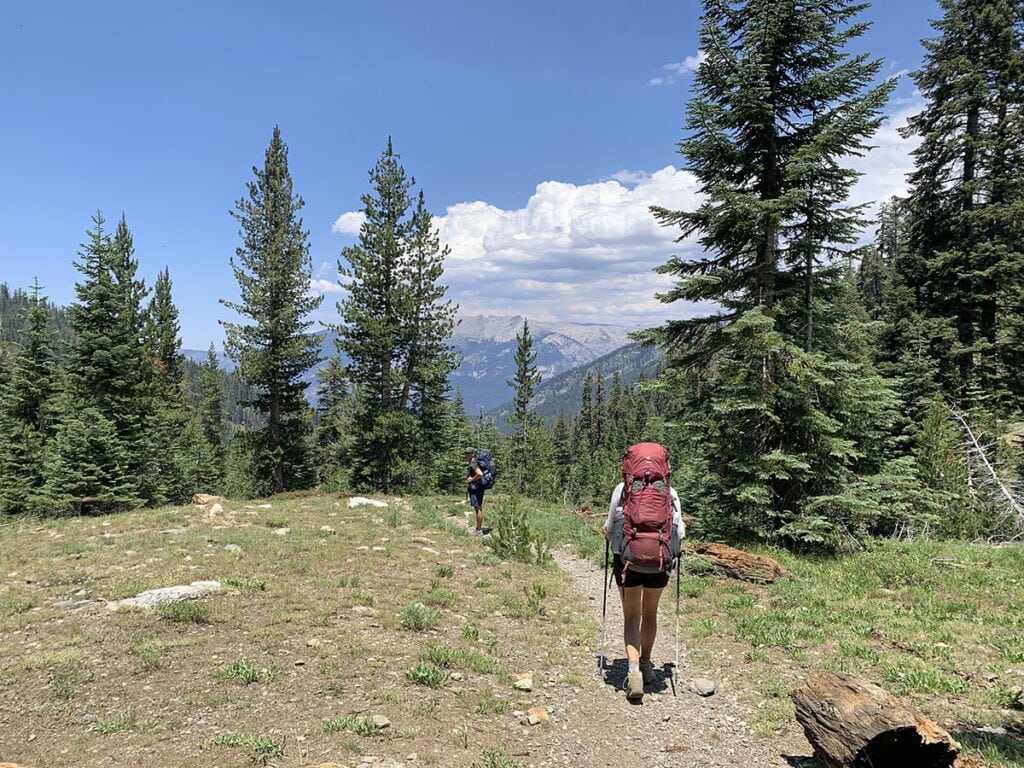Backpacking is my favorite way to get outside. Backpacking gives you the opportunity to completely unplug, immerse yourself in nature, challenge yourself physically, and forget about the worries of everyday life.
If you’ve never been backpacking before, it’s likely one of these things that is inspiring you go on your first backpacking trip.
My first time backpacking was in 2005, and when I started backpacking, I made a lot of common backpacking mistakes. The weren’t a ton of backpacking 101 resources then, so it was trial by fire.
Since then, I’ve backpacked more than 1,000 miles on some of the most iconic and remote trails in the US, and I’ve accumulated all of the beginner backpacking tips I wish I knew when I was learning how to backpack.
So in this backpacking for beginner’s guide, I’m going to teach you the basics of how to start backpacking. You’ll learn all about everything involved with planning a backpacking trip like choosing a trail, the gear you need, backpacking food, safety, and more.
My goal is to help you feel more organized, confident, and less overwhelmed as you get ready for your backpacking adventure.
This post may contain affiliate links.
Choosing a Destination
Pick the dates for your backpacking trip
The dates for your backpacking trip will dictate where you can go due to the weather. Good weather makes backpacking much easier, and that’s what we are shooting for on your first backpacking trip.
Once you’ve decided on the season you want to backpack in, you can narrow down the specific area you want to visit.
Pick a Trail
As a beginner backpacker, plan a trip for 1-2 nights on an easy trail to get some good experience under your belt. Shorter, easier trips are a great way to get comfortable carrying your pack, setting up your gear, and learning the ropes without overextending yourself.
To find a trail, use one of the popular trail finder apps, read your favorite outdoor blogs, buy a trail book for the region you’re interested in, or do a google search for “best backpacking trails in ….”
Here are a few things you should look for when choosing a trail for your first time backpacking:
Check permit requirements
After you’ve chosen where and when you’re going backpacking, check to see if a permit is required.
Many trails, especially popular trails in National Parks, require wilderness permits that need to be reserved months in advance. If this is the case, it’s best to have some wiggle room in your trip dates in case your dates are already full.
In some cases, a number of permits are held on a first-come, first-serve basis but for popular trails and dates such as weekends, you’ll need to arrive before the ranger station opens and should have a backup plan in case you’re not able to get a permit.
Depending on where you are backpacking, your permit may have additional requirements. For instance, if you are traveling in bear country (Sierra Nevada, Montana, Wyoming, etc), you may be required to carry your food and scented items in a bear-proof container or bag. Or on popular trails, you might be required to pack out your poop in wag bags.
Plan your transportation
Transportation depends largely on what kind of trail you’re doing, and whether you are backpacking solo or going with a group. Look at a topographic map to find the trailhead and designated parking areas.
If you are hiking a loop trail or an out-and-back, you won’t need an additional car. However, if you’ve chosen to hike point-to-point, you’ll have to drop a second car off at the other end of the trail before beginning your hike or arrange for a shuttle service.
What Gear to Bring Backpacking
Backpacking gear can be expensive. If you’re committed and are confident this is going to be your first backpacking trip of many, I’d encourage you to invest in quality, lightweight gear from the get-go. Lighter gear is going to make your trip more enjoyable, and you’d hate to buy heavier gear only to replace it after a few trips.
Backpacking Essentials
The most important beginner backpacking tips tend to revolve around gear. It’s so easy to overpack and end up with a crazy heavy pack that leaves you wondering why on earth you decided to start backpacking. On the other hand, you also don’t want to forget any important backpacking essentials that can make or break your trip.
For a full run-down on the backpacking gear you need, start with my 3-day backpacking checklist. That list has the gear I actually use on every single trip and you can refer to it to make sure you don’t forget anything.
However, some of that gear I mention in that post is quite expensive for a beginner backpacker, so I’m recommending some more budget-friendly backpacking essentials here:
For more recommendations and some of my favorite backpacking gear over the years, check out the posts below
What to do if you can’t afford new backpacking gear
If you simply can’t afford an entirely new backpacking kit, here are a few suggestions on how to acquire your backpacking gear without spending an arm and a leg:
What to Wear Backpacking
What to wear backpacking looks a lot like what to wear hiking. For beginner backpackers, investing in a few good-quality basics that will last you a long time is key to being comfortable on the trail.
Here’s a few backpacking clothing tips for beginners:
For a full list of the clothing I bring backpacking, see my 3-day backpacking checklist and the posts linked to below.

Backpacking Food
Planning your food for a backpacking trip can be one of the most intimidating parts of planning. You burn a lot of calories walking for hours with a heavy load on your back, so having adequate food is critical. Eating frequently will keep your energy levels up and help you stay focused, alert, and aware.
Here are some tips to simplify your food planning:

Packing your Backpack
Packing all of your backpacking gear in your backpack is a bit on an art, and you will get better at each morning. Ideally you want as much of your stuff to fit inside the pack as possible. Hanging stuff all over the outside can affect your balance. If you’re finding consistently unable to fit everything inside, it might be best to consider a larger backpack.
Here are some tips for loading up your pack:
For more tips, see my post on how to pack your backpacking pack.

Backpacking Safety
Staying safe while backpacking requires taking proper precautions and using good judgment. Here are a few things to keep in mind while you’re backpacking. Visit my post on hiking safety tips for more detailed advice.

Backpacking Hygiene
As a beginner backpacker, you may wonder how to maintain your hygiene while you’re backpacking. Luckily it’s not that hard, but I have a few tricks to share that I wish I knew when I first started backpacking.

How to Leave No Trace While Backpacking
This backpacking for beginners crash course wouldn’t be complete without talking about Leave No Trace. Leave No Trace is a set of principles designed to guide our actions in the outdoors into order to reduce our impact.
Also, take the time to familiarize yourself with the unspoken rules of proper trail etiquette. In a nutshell, be kind to other hikers, the uphill hiker has the right of way, and be mindful of how your actions are affecting others who are trying to enjoy their time in the wilderness.
How to Physically Train for Backpacking
When getting started with backpacking, I recommend choosing trails and trips that are in line with your current fitness levels. Just like hiking, backpacking is a great way to kick-start your exercise routine and get in shape, but trying to tackle a super challenging trail might not be fun and could discourage you from going again.
Prior to your first multi-day trip, doing some physical preparation and establishing a healthy awareness of your capabilities will help grow your confidence as a first-time backpacker.
Training and stretching
The best way to get in shape for backpacking is to get moving. I recommend going for as many local hikes and walks around your neighborhood as you can. Load up your pack with some weight so you can prepare your body for carrying a heavier load than you are used to.
Train for hiking as you’d train for a 5K run, by creating a plan that starts slow while ramping up your distance and intensity as you progress.
Be sure to work a few gentle stretches and exercises into your normal routine to help build the strength you need to successfully hike with a backpacking pack.
Remember to always listen to your body and any pain signals, as this can be great training for knowing when to push yourself or call it a day on bigger and more challenging backpacking trips.
Dealing with aches and pains
Backpacking is hard work, and it can leave your body and joints tired and achy. If you have weak knees or sensitive feet, there are proactive steps you can take to prevent multi-day hikes from taking a big toll on your body.
The last thing you want is to be out on the trail for days and be in pain so learn how to protect your knees while hiking and eliminate hiker foot pain to better enjoy the trails.
Improving your lung capacity
Another thing that used to bother me when I was a beginner hiker and first getting into backpacking was I’d always be so out of breath on the trail. I felt embarrassed, and it prevented me from hiking with people who I knew were in better shape than me.
Twenty years later, I still get out of breath very easily, even at my peak fitness levels. The point is for many people, getting out of breath is completely normal, but if it bothers you or you find it uncomfortable, check out these simple exercises and steps you can take to improve your lung capacity.
Save this post to Pinterest
I hope this backpacking for beginners guide gives you the information you need to plan your first backpacking trip. Got any questions? Leave a comment below!


